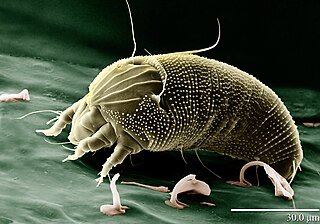 W
WAceria anthocoptes, also known as the russet mite, rust mite, thistle mite or the Canada thistle mite, is a species of mite that belongs to the family Eriophyidae. It was first described by Alfred Nalepa in 1892.
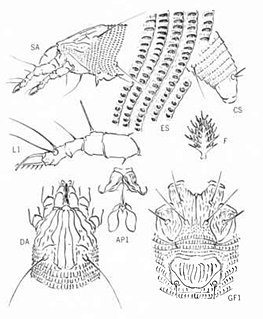 W
WThe eriophyid coconut mite, Aceria guerreronis, is a mite which infests coconut plantations. It is economically devastating, and can destroy up to 60% of coconut production. The immature nuts are infested and injured by mites feeding in the portion covered by the perianth of the immature nut.
 W
WAceria tosichella, commonly known as the wheat curl mite (WCM), is a global cereal pest and a vector for spreading and transmission of viruses like wheat streak mosaic virus (WSMV) and wheat mosaic virus (WMoV)
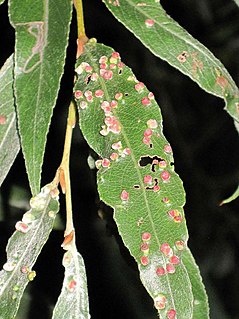 W
WAculus tetanothrix is a species of mite which causes galls on the leaves of willows. It was first described by Alfred Nalepa in 1889.
 W
WAmblyomma americanum, also known as the lone star tick, the northeastern water tick, or the turkey tick, or the ‘’Cricker Tick’’, is a type of tick indigenous to much of the eastern United States and Mexico, that bites painlessly and commonly goes unnoticed, remaining attached to its host for as long as seven days until it is fully engorged with blood. It is a member of the phylum Arthropoda, class Arachnida. The adult lone star tick is sexually dimorphic, named for a silvery-white, star-shaped spot or "lone star" present near the center of the posterior portion of the adult female shield (scutum); adult males conversely have varied white streaks or spots around the margins of their shields.
 W
WAmblyomma maculatum is a species of tick in the genus Amblyomma. Immatures usually infest small mammals and birds that dwell on the ground; cotton rats may be particularly favored hosts. Some recorded hosts include:Geothlypis trichas Cardinalis cardinalis Passerina ciris Sialia sialis Thryothorus ludovicianus Troglodytes aedon Zonotrichia albicollis Dog Dama dama Human Eastern woodrat Odocoileus virginianus Marsh rice rat Cotton mouse Hispid cotton rat Pig Sylvilagus palustris
 W
WAmmotrechidae is a family of solifuges distributed in the Americas and the Caribbean Islands. It includes 22 described genera and at least 83 species. Members of this family can be distinguished from members of other families by the absence of claws on tarsi of leg I, tarsal segmentation 1-2-2-(2-4), pedipalps with pairs of lateroventral spines, and by males having an immovable flagellum on the mesal face of each chelicerum. The propeltidium of the Ammotrechidae is recurved.
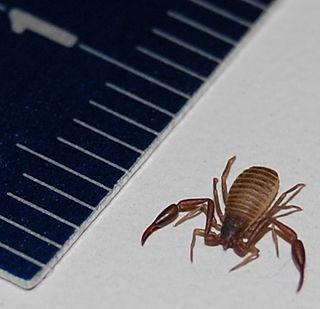 W
WChelifer cancroides, the house pseudoscorpion, is a species of pseudoscorpions. It is a cosmopolitan, synanthropic, and harmless species to humans.
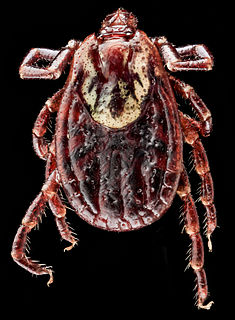 W
WDermacentor variabilis, also known as the American dog tick or wood tick, is a species of tick that is known to carry bacteria responsible for several diseases in humans, including Rocky Mountain spotted fever and tularemia. It is one of the best-known hard ticks. Diseases are spread when it sucks blood from the host. It may take several days for the host to experience symptoms.
 W
WEremobates is a genus of arachnids of the order Solifugae. About 2 inches long, this fast-moving arachnid has the largest jaw size to body ratio of any animal. It is not venomous, but has a remarkably powerful bite. Often hunting at night, it has poor eyesight and navigates mostly by use of a pair of pedipalps.
 W
WFumontana is a genus of harvestman that occurs in the United States with one described species, F. deprehendor.
 W
WHaemaphysalis leporispalustris, the rabbit tick, is a species of tick that is widely distributed in the Americas, stretching from Alaska to Argentina. H. leporispalustris is known to have one of the largest distributions for a tick originating in the New World. It is a three-host tick and a member of the family Ixodidae, commonly called the "hard ticks," and the genus Haemaphysalis. Its common hosts are rabbits, hares, and sometimes ground-feeding birds. H. leporispalustris has a rigid scutum and a prominent capitulum projecting forward from its body and is often said to look like the "wood tick". It has a hemimetabolic life cycle. H. leporispalustris does not play a prominent role in disease transmission in humans but is a vector for disease in other animals.
 W
WHaemogamasus is a genus of mites in the family Haemogamasidae. In North America, they mostly infect rodents, in addition to other small mammals such as shrews, talpids, and Virginia opossums.
 W
WHygrobatoidea is a superfamily of water mites found in North America.
 W
WIxodes angustus is a species of parasitic tick, whose range encompasses the majority of Canada and the United States, along with parts of northern Mexico. I. angustus is a member of the Ixodidae (hard-bodied) family of ticks. It is most abundant in cool, moist biomes such as riparian, boreal or montane zones. I. angustus is a host generalist and has been discovered feeding on more than 90 different host species, including humans and domestic dogs. I. angustus has been identified as a potential vector for Lyme disease but is not considered a principle vector due to the relative rarity with which it feeds on humans.
 W
WIxodes pacificus, the western black-legged tick, is a species of parasitic tick found on the western coast of North America. I. pacificus is a member of the Ixodidae (hard-bodied) family. It is the principal vector of Lyme disease in that region. I. pacificus typically feeds on lizards and small mammals therefore its rate of transmission of Lyme disease to humans is around 1% of adults. It is an ectoparasite that attaches itself to the outside of its host and feeds on the hosts blood meal. It can have a heteroxenous lifestyle or monoxenous life cycle depending on how many hosts it feeds on in each cycle. I. pacificus has a four stage life cycle that takes around 3 years to complete. These stages include egg, larva, nymph, and adult. They prefer dense woodland habitats or areas of brush and tall grass.
 W
WIxodes scapularis is commonly known as the deer tick or black-legged tick, and in some parts of the US as the bear tick. It is a hard-bodied tick found in the eastern and northern Midwest of the United States as well as in southeastern Canada. It is a vector for several diseases of animals, including humans and is known as the deer tick owing to its habit of parasitizing the white-tailed deer. It is also known to parasitize mice, lizards, migratory birds, etc. especially while the tick is in the larval or nymphal stage.
 W
WIxodes uriae, also known as the seabird tick, is a species of parasitic tick known to infect marine birds. It is native to many high latitude areas in the northern and southern hemispheres including Alaska, Canada, Faroe Islands, Iceland, Greenland, England, Scotland, Norway, Finland, the Kola Peninsula, Russia, Patagonia, South Africa and Australia.
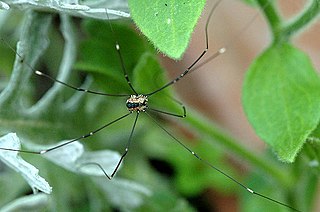 W
WLeiobunum is a genus of the harvestman family Sclerosomatidae with more than a hundred described species. Contrary to popular belief, they are not spiders, although they share a resemblance. They are arachnids, in the order Opiliones, harvestmen. Species in Leiobunum tend to have relatively long legs compared with other harvestmen, and some species are gregarious.
 W
WMastigoproctus giganteus, the giant whip scorpion, also called the giant vinegaroon or grampus, is a species of whip scorpions in the family Thelyphonidae.
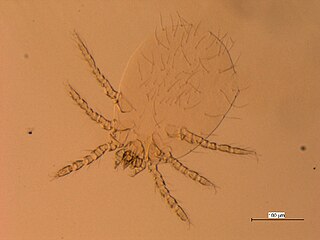 W
WNeotrombicula is a subgenus of mites in the family Trombiculidae. The species of this family are found throughout North America.
 W
WOligonychus ununguis, the spruce spider mite, is a globally widespread pest of spruce. Though not particularly important in the forest, it has been bothersome on planted spruce in the Prairie Provinces, and is considered one of the most important pests of spruce plantations in Ontario. As well, ornamental specimens of spruce and most other conifers throughout the range often suffer damage. The pest is barely visible without the aid of a magnifier and is rarely noticed until discoloured foliage is found on an affected tree. To check for the presence of mites, sharply jar suspected foliage over a piece of white paper, and watch for movement of tiny objects. If a red stain appears when the objects are smeared against the paper, the probability is high that spider mites are present.
 W
WOrnithodoros hermsi is a species of soft tick. It can be infected with Borrelia hermsii.
 W
WOrnithodoros kelleyi is an argasid tick parasite of bats found widely throughout North America in caves and other natural and man-made features that harbor bats. The species has not been shown to be a major vector of pathogens.
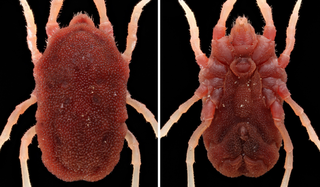 W
WOrnithodoros turicata, commonly referred to as the relapsing fever tick, is a soft tick found in the midwestern and southwestern United States. It is a known vector of Borrelia turicatae, a spirochete responsible for tick-borne relapsing fever in humans. Additionally, vector competence for the transmission of Leptospira pomona, the agent of canine jaundice, has been demonstrated in a laboratory setting.
 W
WOtobius megnini, also known as the spinose ear tick, is a soft-bodied tick that is only parasitic in the larval and nymphal stages. As its common name suggests, the spinose ear tick's parasitic forms are usually found within the ears of the definitive host. This tick has a worldwide distribution, with common hosts that include horses, cattle, sheep, goats, and dogs.
 W
WPhalangium opilio is "the most widespread species of harvestman in the world", occurring natively in Europe, and much of Asia. The species has been introduced to North America, North Africa and New Zealand. It is found in a wide range of habitats, including meadows, bogs, forests, and various types of anthropogenic habitats, such as gardens, fields, hedgerows, lawns, quarries, green places in built-up areas, walls and bridges. Phalangium opilio is known to feed on Helicoverpa zea eggs, and thus can act as biological pest control for soybean crops. The species is nocturnal, as is typical of opilionids.
 W
WPhrynus longipes is a species of amblypygid often found in the Caribbean. Within this region, however, Phrynus longipes lives in an array of habitats from caves to coastlines. Being nocturnal predators, they take shelter during the day and hunt primarily at night. Phrynus longipes has been the first amblypygid to be recorded feeding on an avian species.
 W
WSabacon cavicolens is a species of harvestman.
 W
WSclerobunus is a genus of harvestman that occurs in western North America.
 W
WSclerobunus robustus is a species of harvestman that occurs in the western United States, including Arizona, Colorado, New Mexico, and Utah. The species formerly consisted of three subspecies, two of which were elevated to full species status in 2014.
 W
WTrogulus tricarinatus is a species of harvestman. It is found in Europe and North America.
 W
WTrombicula is a genus of harvest mites in the Trombiculidae family. In their larval stage, they attach to various animals, including humans, and feed on skin, often causing itching. These relatives of ticks are nearly microscopic, measuring 0.4 mm (0.01 in) and have a chrome-orange hue. A common species of harvest mite in North America is Trombicula alfreddugesi; in the UK, the most prevalent harvest mite is Trombicula autumnalis.
 W
WTrombicula alfreddugesi, also called Eutrombicula alfreddugesi, is a species in the genus Trombicula.
 W
WThis is a list of arachnids observed in the U.S. state of Utah.